
Edward Clark Potter was an American sculptor best known for his equestrian and animal statues. His most famous works are the marble lions, nicknamed Patience and Fortitude, in front of the New York Public Library Main Branch

Alexander Milne Calder (MILL-nee) was a Scottish American sculptor best known for the architectural sculpture of Philadelphia City Hall. Both his son, Alexander Stirling Calder, and grandson, Sandy Calder, became significant sculptors in the 20th century.
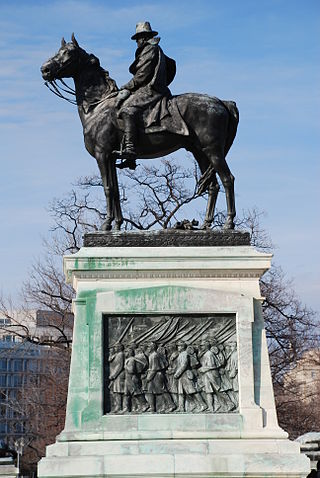
The Ulysses S. Grant Memorial is a presidential memorial in Washington, D.C., honoring American Civil War general and 18th United States President Ulysses S. Grant. It sits at the base of Capitol Hill, below the west front of the United States Capitol. Its central sculpture of Grant on horseback faces west, overlooking the Capitol Reflecting Pool and facing toward the Lincoln Memorial, which honors Grant's wartime president, Abraham Lincoln. Grant's statue is raised on a pedestal decorated with bronze reliefs of the infantry; flanking pedestals hold statues of protective lions and bronze representations of the Union cavalry and artillery. The whole is connected with marble covered platforms, balustrades, and stairs. The Grant and Lincoln memorials define the eastern and western ends, respectively, of the National Mall.

George Edwin Bissell was an American sculptor.
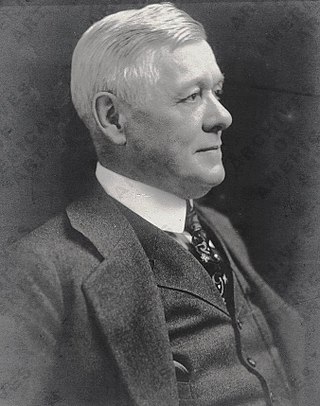
John Massey Rhind was a Scottish-American sculptor. Among Rhind's better known works is the marble statue of Dr. Crawford W. Long located in the National Statuary Hall Collection in Washington D.C. (1926).
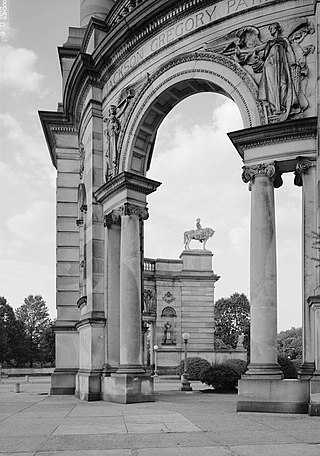
Smith Memorial Arch is an American Civil War monument at South Concourse and Lansdowne Drive in Philadelphia, Pennsylvania. Built on the former grounds of the 1876 Centennial Exposition, it serves as a gateway to West Fairmount Park. The Memorial consists of two colossal columns supported by curving, neo-Baroque arches, and adorned with 13 individual portrait sculptures ; two eagles standing on globes; and architectural reliefs of eight allegorical figures.
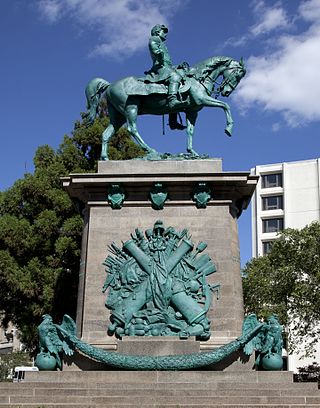
Major General George B. McClellan is an equestrian statue in Washington, D.C. that honors politician and Civil War general George B. McClellan. The monument is sited on a prominent location in the Kalorama Triangle neighborhood due to efforts made by area residents. The statue was sculpted by American artist Frederick William MacMonnies, a graduate of the École des Beaux-Arts whose best known work is a statue of Nathan Hale in New York City. MacMonnies was chosen to design the statue following a lengthy competition organized by a statue commission, led by then Secretary of War William Howard Taft. The monument was dedicated in 1907, with prominent attendees at the ceremony including President Theodore Roosevelt, New York City mayor George B. McClellan Jr., politicians, generals and thousands of military personnel.

Jakob Otto Schweizer was a Swiss-American sculptor noted for his work on war memorials.

The General William Tecumseh Sherman Monument is an equestrian statue of American Civil War Major General William Tecumseh Sherman located in Sherman Plaza, which is part of President's Park in Washington, D.C., in the United States. The selection of an artist in 1896 to design the monument was highly controversial. During the monument's design phase, artist Carl Rohl-Smith died, and his memorial was finished by a number of other sculptors. The Sherman statue was unveiled in 1903. It is a contributing property to the Civil War Monuments in Washington, D.C. and to the President's Park South, both of which are historic sites listed on the National Register of Historic Places.

Lincoln Monument (Philadelphia) is a monument honoring Abraham Lincoln in Fairmount Park, Philadelphia, Pennsylvania, United States. One of the first initiated in memory of the assassinated president, the monument was designed by neoclassical sculptor Randolph Rogers and completed in 1871. It is now located northeast of the intersection of Kelly Drive and Sedgley Drive, opposite Boathouse Row.

The James A. Garfield Monument is a monument honoring the 20th President of the United States in Philadelphia, Pennsylvania, United States. Sculptor Augustus Saint-Gaudens and architect Stanford White collaborated on the memorial, which was completed in 1896. It is located in Fairmount Park, along Kelly Drive, near the Girard Avenue Bridge.

The equestrian statue of Charles Devens is a public monument in Worcester, Massachusetts, United States. Located in front of the old Worcester County Courthouse in the Institutional District, the equestrian statue honors Charles Devens, who served as a general in the Union Army during the American Civil War and later served as United States Attorney General. The statue was designed by Daniel Chester French and Edward Clark Potter and was dedicated on July 4, 1906.

Marquis de Lafayette is a monumental statue on the campus of Lafayette College in Easton, Pennsylvania. The statue, designed by Daniel Chester French and standing on a pedestal designed by Henry Bacon, was dedicated in 1921 in honor of the college's namesake, Gilbert du Motier, Marquis de Lafayette. The statue is located at the south entrance of Colton Chapel. It is one of a number of sculptures made by French for universities, which includes the statue of John Harvard at Harvard University and Alma Mater at Columbia University.
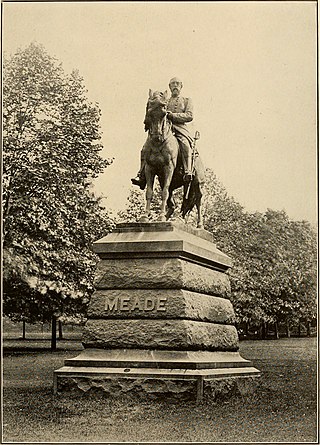
Major General George Gordon Meade is an equestrian statue that stands in Philadelphia's Fairmount Park. The statue, which was unveiled in 1887, was designed by sculptor Alexander Milne Calder and honors George Meade, who had served as an officer in the Union Army during the American Civil War and was later a commissioner for the park. The statue is one of two statues of Meade at Fairmount, with the other one being a part of the Smith Memorial Arch.

The Ulysses S. Grant Monument is a presidential memorial in Chicago, honoring American Civil War general and 18th President of the United States Ulysses S. Grant. Located in Lincoln Park, the statue was commissioned shortly after the president's death in 1885 and was completed in 1891. Several artists submitted sketches, and Louis Rebisso was selected to design the statue, with a granite pedestal suggested by William Le Baron Jenney. At the time of its completion, the monument was the largest bronze statue cast in the United States, and over 250,000 people were present at the dedication.
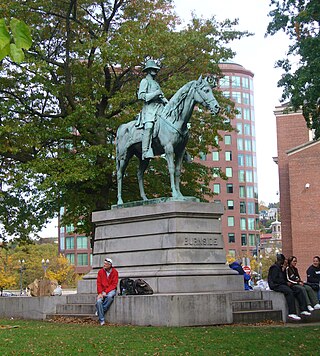
Major General Ambrose E. Burnside, also known as the Ambrose Burnside Monument, is a monumental equestrian statue in Providence, Rhode Island, United States. The statue, located in the city's Burnside Park, was designed by sculptor Launt Thompson and depicts Ambrose Burnside, an officer in the Union Army during the American Civil War who later served as the governor of Rhode Island. Ambrose had died in 1881 and the project to erect a statue in his honor began shortly afterwards. It was dedicated on July 4, 1887 in a large ceremony that included several notable guests of honor, such as General William Tecumseh Sherman, Colonel Robert Hale Ives Goddard, and the governors of both Connecticut and Rhode Island. The monument was originally located in Exchange Place, but it was moved to its current location in the early 1900s. As part of the move, the pedestal was replaced with one designed by William R. Walker.

Major General David McMurtrie Gregg is a monumental statue located in Reading, Pennsylvania, United States. The monument was designed by Henry Augustus Lukeman and consists of an equestrian statue depicting David McMurtrie Gregg, a military officer who had served in the Union Army during the American Civil War. The monument was dedicated in 1922, several years after Gregg's death in Reading in 1916.

Matthias William Baldwin is a monumental statue located outside Philadelphia City Hall in Philadelphia, Pennsylvania, United States. The statue honors industrialist and philanthropist Matthias W. Baldwin and was designed by sculptor Herbert Adams. It was dedicated in 1906 and moved to its present location in 1921.





















